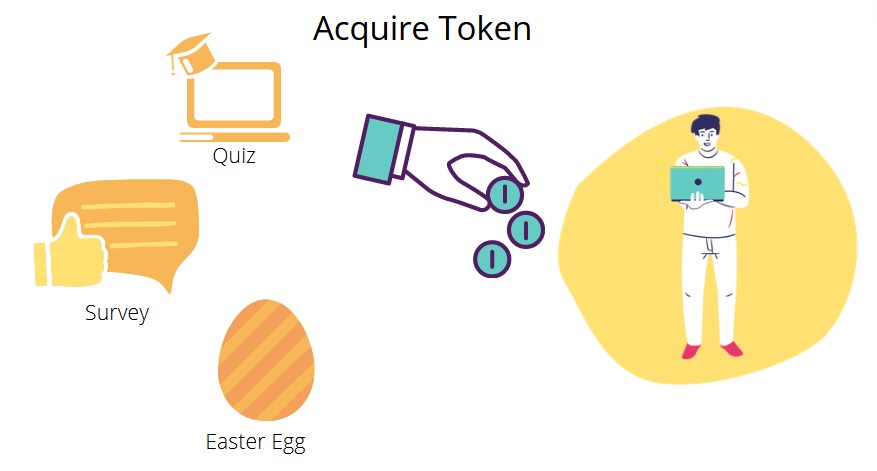Usage of Tokens in E-Learning Part 1 – Earning Tokens
Last Updated on 12. August 2024 by Martin Schuster
This is the first part of two articles about the usage of tokens in e-learning. In this article, we explore the usage of tokens in an e-learning platform and how they can enhance the acceptance of the platform and increase the learning success. The article is divided into two parts. First, we take a look at how students can obtain tokens and second, we take a look at how they can spend the tokens.
Why Tokens?
There are several reasons why tokens can be implemented on a learning platform:
- to motivate users to interact with the platform or to learn,
- to acquire new users, or
- to develop an entire ecosystem where content creators are also rewarded with tokens.
On traditional learning platforms, the use of tokens can enhance the uniqueness of the project and new projects can also use tokens for funding.

Performance-based Tokens
A reward system can be used as a basis, which motivates users to perform certain activities. They can be rewarded for finishing a course or a lesson based on a foreseeable or random principle. In addition to just consuming the content, comprehension can also be tested in quizzes, and their passing can be linked to receiving tokens. Also, improvement in repeated participation in a test can be rewarded with tokens. In this case, a balanced approach must be taken that is incentive-compatible to avoid rewarding misbehavior, such as intentionally performing poorly to improve considerably afterward. In general, a gamification approach to learning can adopt the Play to Earn (P2E) business model. In the Learn to Earn (L2E) adaptation, DeFi, gamification, and knowledge acquisition are combined. This combination can revolutionize a learning platform and generate benefits for all parties.
Interaction-based Token
In addition to increased learning, tokens can also be used as an incentive for other activities on a learning platform. For instance, processes such as registration or the entry of profile data can be stimulated token awarding. In this way, the user can be bound to the platform from the beginning and also agree to receive a newsletter in exchange for further tokens.
Recommendations
It also helps platform operators to support actions with tokens that bring them new users. This includes recommending to “friends and family” as well as posting feedback. Thus, users can either receive a fixed number of tokens if they get another person to sign up to the platform as well. Another idea would be to participate in the success of the recommended friend. This way, they can continue to motivate themselves even after registration. The problem here is that a user could create fake accounts to receive tokens as a reward. Contributing to success of this newly added user makes fake accounts impractical because each account would have to proof its learning success. This could be considered as a kind of proof of work spam protection scheme.
Feedback
Feedback is a great way to learn about the wishes of users. It can be the starting point for improvements of the platform. Besides that, it can also be published and show new users what they can expect from subscribing.
Due to this added value of feedback and surveys, the platform should provide an incentive for users to participate in as many surveys as possible. Tokens are a way to reward users for their efforts. But tokens can be used not only as an incentive. They can also reflect the user’s experience. If a user has collected many tokens on the platform, he has also been able to gain a lot of experience. Therefore, his opinion can be rated higher than a new member’s opinion. They, in turn, could be required to collect a certain number of tokens before their feedback is published, thereby creating a kind of spam filter.
Advertisement
In addition to free content, users could also be rewarded with tokens for consuming advertising content. This could include not only videos and banners for other companies’ products and services. Instead, advertising could also be packaged in a small course on a learning platform. The advertiser could present its benefits and products in the course and then reward the user for taking the course – either with its own advertised tokens, or with the platform token. This combination of advertising and tokens combats ad blockers and allows you to work with other projects.
Luck
If you want to encourage interaction with the platform in general, Easter Eggs can provide the appropriate appeal for users. In the process, users are surprised with a reward at random points on the platform. Possible interactions in which tokens can be “hidden” include using and exploring tools and offers outside the courses. But also, a simple unfolding of further information can reveal an Easter Egg – the possibilities are endless. Tokens can also be used to reward visits to the platform by already registered users. This can be done by rewarding and encouraging consistency, e.g., by giving tokens to the user after a week of daily logins. It can also motivate users to return after a long absence, e.g., by sending them an e-mail promising them tokens on their return. Likewise, the tokens can also be issued only upon return, without prior notice. Above all, the reward based on a sustained streak can be very effective, as can the threat of missing out on tokens if you no longer visit the platform.

 Register
Register Sign in
Sign in